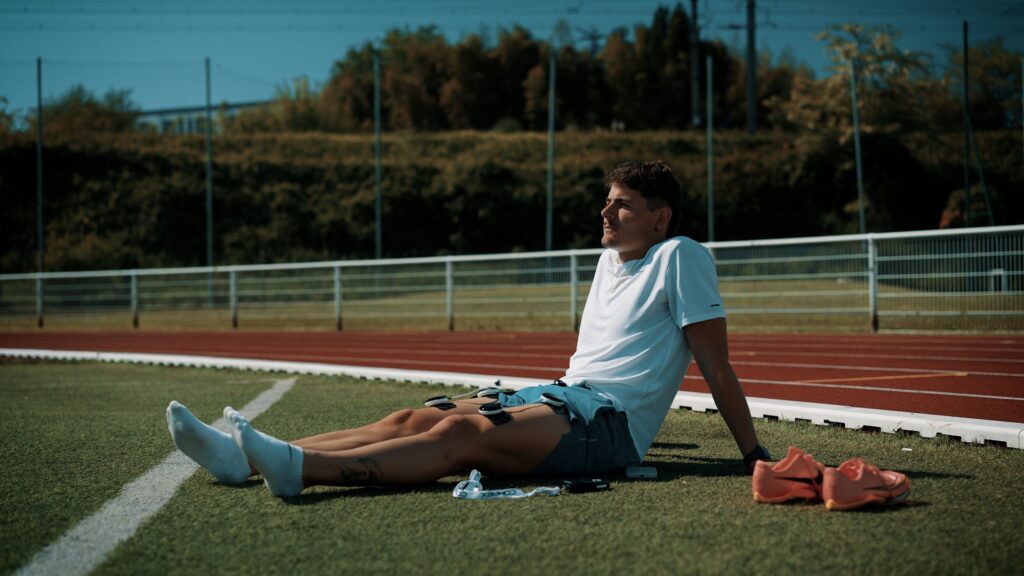July 3 to 5, 2026
Compex joins the MB Race adventure and helps you prepare for your goal! After our advice on physical preparation with electrostimulation, we’re now going to talk about recovery!
Whether it’s after a training session or a race, recovery is essential to get your body back in top shape. Our Compex partner shares his top tips for optimizing your recovery and staying on top form!
The progression of physical qualities in general, and muscular qualities in particular, is based on the principle of the body’s capacity to adapt. Indeed, after a major strain on a function (cardiac, respiratory…) or an organ (muscles…), the body will put in place tissue repair measures, enabling the development of physical fitness.
The immediate effect of a training session is initially a regression in performance level, followed by a slow return, not to the initial level of performance, but to a slightly higher one.
This is why, with well-planned training, the repetition of training stimuli, alternated with sufficient recovery time, will enable you to gradually reach your optimum level of performance. Conversely, training stimuli that are too intensive, too long or too close together can have the opposite effect to that intended: a reduction in physical qualities.
After an intense training session, the question of the best way to recover often arises. Active and passive recovery are the two main approaches.
Active recovery involves light physical activity after intense effort. Passive recovery, on the other hand, involves total rest or minimal activity after exertion. This can include sitting, lying down or simply walking quietly.
Both methods have their advantages. Active recovery better elimination of lactate, maintenance of blood circulation and reduced muscle soreness. Passive recovery This will allow the nervous system to rest completely, improve glycogen resynthesis and reduce mechanical stress.
There’s no one-size-fits-all approach to recovery .Everyone is different and reacts differently to recovery methods. That’s why it’s essential to experiment and listen to your body. You can choose one method or the other depending on the type of effort you’ve made, your goal for the next session, your general state of fatigue and, of course, your personal preferences. You can even mix the two, starting with a 5-10 min active recovery at a lower intensity and then continuing with a passive recovery for complete rest.
Numerous studies have proven that the benefits of electrostimulation recovery are the same as those of active recovery. There are many advantages to this type of recovery:
Compex electrostimulators have 4 channels, so you can recover quadriceps and calves simultaneously, for example. They offer two types of recovery: after training and after competitions.

Post-training recovery program:
The post-workout recovery program is used immediately after intensive exercise.
The first effect of the program is to provoke a very strong increase in blood circulation in the stimulated area, which favors the drainage of the various toxins accumulated in the muscles.
The second effect, well known to the medical world, is pain relief due to the release of natural substances with analgesic properties (endorphins and enkephalins).
The third and final effect is a reduction in muscle tone, i.e. a reduction in the tension of muscle fibers, which is most often exaggerated after intensive effort.
Post-competition recovery program :
The post-competition recovery program is used immediately after a strenuous effort. The particular rhythm of the session reduces the risk of muscle cramps.
It begins, for the first 4 minutes, with a reduction in muscle tone to reduce the risk of cramps, then continues with the same effects as the Post-Training Recovery program.

Pressotherapy is a method that uses air pressure to improve blood circulation, reduce muscle pain and promote lymphatic drainage. By exerting controlled pressure on the limbs, it promotes the flow of oxygen-rich blood to the muscles. The result is faster recovery. In addition, this technique promotes the elimination of metabolic waste and toxins from the body via the lymphatic system. It also supports the body’s natural detoxification process.
You can find out more about Compex’s AYRE Wireless compression boots here.
You can also use the various Compex massage guns to reduce muscle pain and relax tense muscles after a workout or run.
Whatever recovery method you choose, don’t forget that hydration and nutrition play a major role in muscle recovery. You can (re)discover our partner Overstims’ advice for this part.
And don’t forget, go to your runner’s area to discover a surprise from our partner Compex…